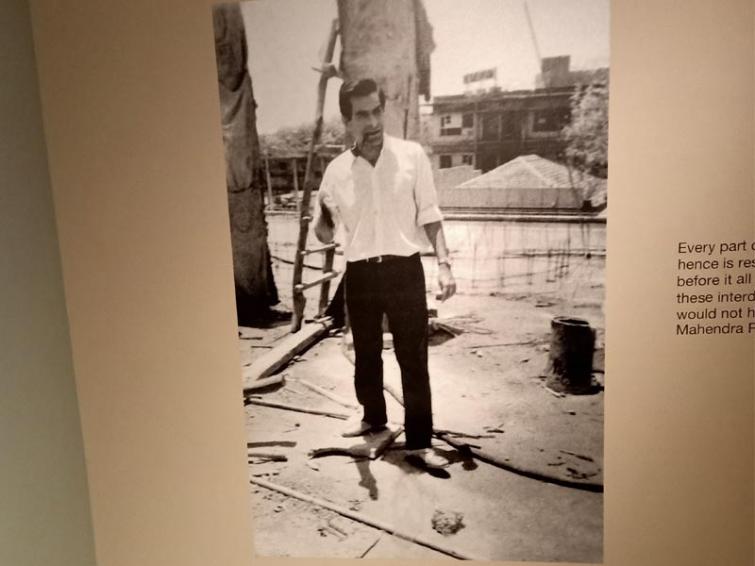
KNMA presents Structuring Form - the Innovative Rigour of Mahendra Raj
IBNS/Kolkata: Delhi-based Kiran Nadar Museum of Art is holding a special exhibition highlighting some of the architectural projects of Mahendra Raj, one of the best known structural designers of India.
The exhibition is showcasing seven architectural projects out of his two hundred fifty projects.
Conceptualized by Rohit Raj Mehndiratta and Vandini Mehta, and Roobina Karode as the curatorial advisor, the exhibition is on view till December 26, 2019 at KNMA Saket.
The collaborative alliance between the architect and the structural engineer (and teams) often remains understated.
The productive process and nature of working together may enter explorations of new construction materials, arriving at exciting patterns and textures, sourcing low cost materials and articulating in built forms, the dramatic play between space and scale.
The projects like the Hall of Nation in New Delhi, the Akbar Hotel and NCDC Office building in New Delhi, the Hindon River Mills in Ghaziabad, the Municipal Stadium and Tagore Memorial Theatre in Ahmedabad, and the Indoor Sports Stadium in Srinagar find special place in this exhibition, alongside chronicling the career of this engineering innovator.
Architects like Charles Correa (Municipal Stadium, Ahmedabad), Raj Rewal (Hall of Nation), BV Doshi (Tagore Memorial Hall), Kuldeep Singh (NCDC Building) are considered pillars of modern India architecture.
It was arguably their partnership with a structural engineer like Mahendra Raj that gave Indis some of the phenomenal modernist architecture.
Mahendra Raj’s career can be mapped across the period of India’s post-independence modernisation, a period marked by massive constructions which eventually changed its urban landscape.
It is said that throughout several ups and downs witnessed by the Indian economy over the decades, the developmental work that entailed a nation’s infrastructure was distinguished by recruiting a resourceful, avant-garde pioneer like Mahendra Raj.
Concrete as building material was popular across the world, when Mahendra Raj executed these structures.
However, the material had its own limitations.
Raj used this shortcoming to his advantage and experimented with structures, with the availability of affordable material and labour.
“Mahendra Raj has carried the whole modern Indian architecture on his shoulders. My interaction with him was like a jugalbandi that has helped enhance and execute my visions," said leading Indian architect Raj Rewal, while describing the immense skill and tenacity with which Mahendra Raj, executed these magnificent structures.
Mahendra Raj’s ingenuity lay in the fact that he deployed easily available manual labour as well as construction material to craft his structures almost like artefacts, so unique that they went on to become his signature aesthetics.
Th book ‘The Structure, Works of Mahendra Raj’, 2016, edited by Vandini Mehta, Rohit Raj Mehndiratta and Ariel Huber, it is said that "his life and work garners much more relevance and attention in present times with the growing threat of demolition of modern structures like the iconic Hall of Nations, one of the featured projects in the exhibition, was razed to dust in 2017. The archive of his structures along with recent photographs indicate the power and elegance of different structures as they were constructed and laying bare the engineering inventiveness of Mahendra Raj. The drawings, especially the blueprints reveal the ‘techne’ of construction in different decades of Raj’s practice. These buildings were iconic objects, many with a commanding presence and setting, compelling one to look upon him as a craftsperson, even artist-visionary of his times and after."
Established by art collector Kiran Nadar in 2010, the Kiran Nadar Museum of Art (KNMA) is the first privately-funded museum of art exhibiting modern and contemporary works from India athe sub-continent.
Located in New Delhi NCR, India’s capital city, KNMA hosts an ever-growing collection of artworks that both highlights a magnificent generation of 20th-century Indian painters from the post-Independence decades and engages with the different art practices of younger contemporaries.
Sponsored by the Shiv Nadar Foundation, KNMA is focused on bridging the gap between art and the public and fostering a museum-going culture in India.
KNMA aims to become a place for confluence, dialogue and collaboration through its curatorial initiatives and exhibitions, school and college workshops, art appreciation discourses, symposiums, and public programs.
https://www.knma.in
Support Our Journalism
We cannot do without you.. your contribution supports unbiased journalism
IBNS is not driven by any ism- not wokeism, not racism, not skewed secularism, not hyper right-wing or left liberal ideals, nor by any hardline religious beliefs or hyper nationalism. We want to serve you good old objective news, as they are. We do not judge or preach. We let people decide for themselves. We only try to present factual and well-sourced news.







